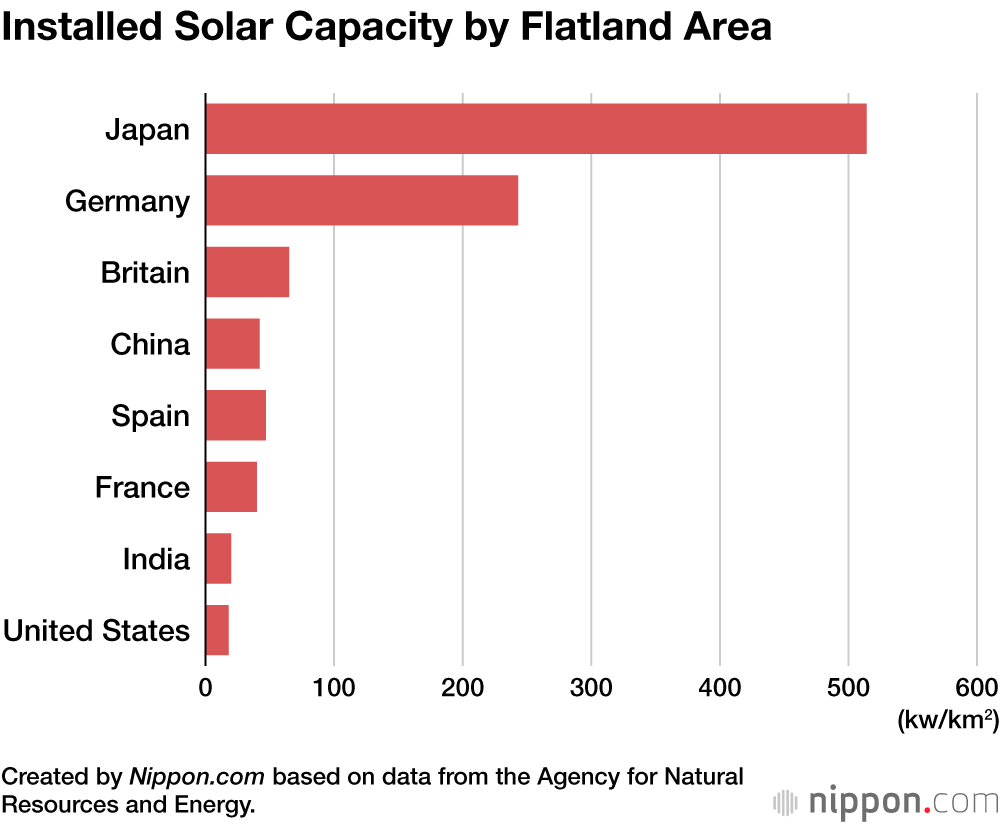
The Promise of Perovskite: Lightweight, Flexible Solar Panels Set for Launch in Japan
Environment Disaster Economy Society- English
- 日本語
- 简体字
- 繁體字
- Français
- Español
- العربية
- Русский
A Critical Moment for Solar
The Japanese government has invested in solar power as a way of reducing emissions of carbon dioxide and other greenhouse gases, but the industry is approaching a critical moment. While solar energy firms had been able to sell to electricity companies at high prices due to a special feed-in tariff system, and municipalities aided the uptake of solar panels with their own subsidies, clear problems have started to emerge, such as friction with local residents concerning the placement of solar sites.
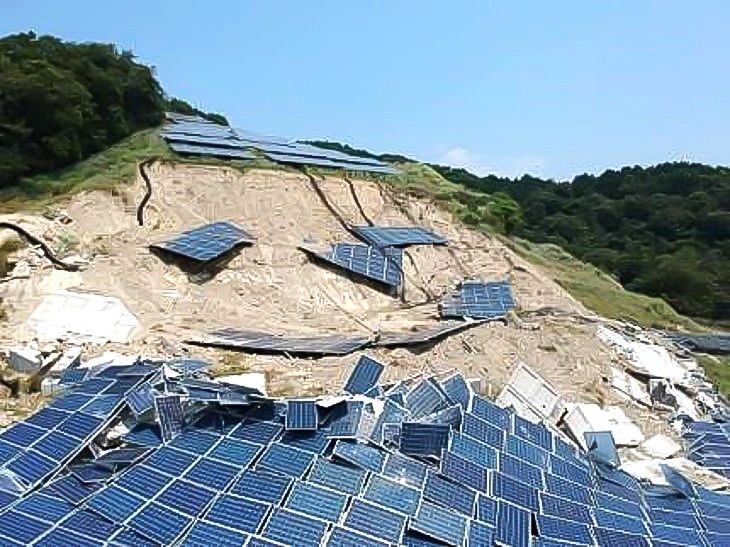
Solar panels washed away with earth in a landslide. (Courtesy the Ministry of Economy, Trade, and Industry)
According to Ministry of Internal Affairs and Communications surveys, there have been issues in 40% of municipalities across Japan where solar power generation has been adopted. Solar facilities built on sloping land, because it is cheap and maximizes exposure, have suffered landslide damage after heavy rain, while in other cases there have been complaints about blinding light reflected from panels. There is no end of cases where insufficient explanations from solar power businesses to residents before installation have led to later problems.
As part of its efforts to achieve carbon neutrality by 2050, the government has set an intermediate target of raising the percentage of electricity generated by solar power to 14%–16% in 2030, or twice its level in fiscal 2019. However, documents from the Agency for Natural Resources and Energy indicate that mountainous Japan already has by far the highest installed solar capacity by flatland area of any major industrialized country, and limited space for growth.
Climate change is becoming more severe, with scorching summers and torrential rains. The energy sector accounts for more than 80% of carbon emissions, but as major concerns remain about restarting nuclear reactors amid frequent disasters, there is a need to consider the best way to expand the use of renewable energy.
Next-Generation Panels
Under these circumstances, the development of thin-film, flexible solar panels is drawing considerable attention.
Solar power is generated when semiconductor materials are exposed to sunlight. Current solar panels are made of fragile silicon, which is protected by glass, making them heavy, at around 10 kilograms per square meter. In contrast, newer generations of solar cells coat a film with a power-generating layer consisting of a compound with a crystal structure called perovskite. Both sides are covered with protective material, but the cells are very thin and flexible, and they are around a tenth the weight of silicon solar panels.
These characteristics create the potential for these new solar cells to be used in new ways, so manufacturers are making every effort to push development forward. Sekisui Chemical, which has targeted commercialization of the next-generation cells in 2025, is now busy responding to an endless stream of inquiries from companies in different industries and local governments.
The initial selling price is likely to be high, but Morita Takeharu, who heads a Sekisui project developing perovskite solar cells, says: “If you consider the possibility that a carbon tax will be introduced in the future, it might be cheaper to use the new cells. Meanwhile some large companies place importance on aspects like increasing their corporate value and displaying social responsibility.”
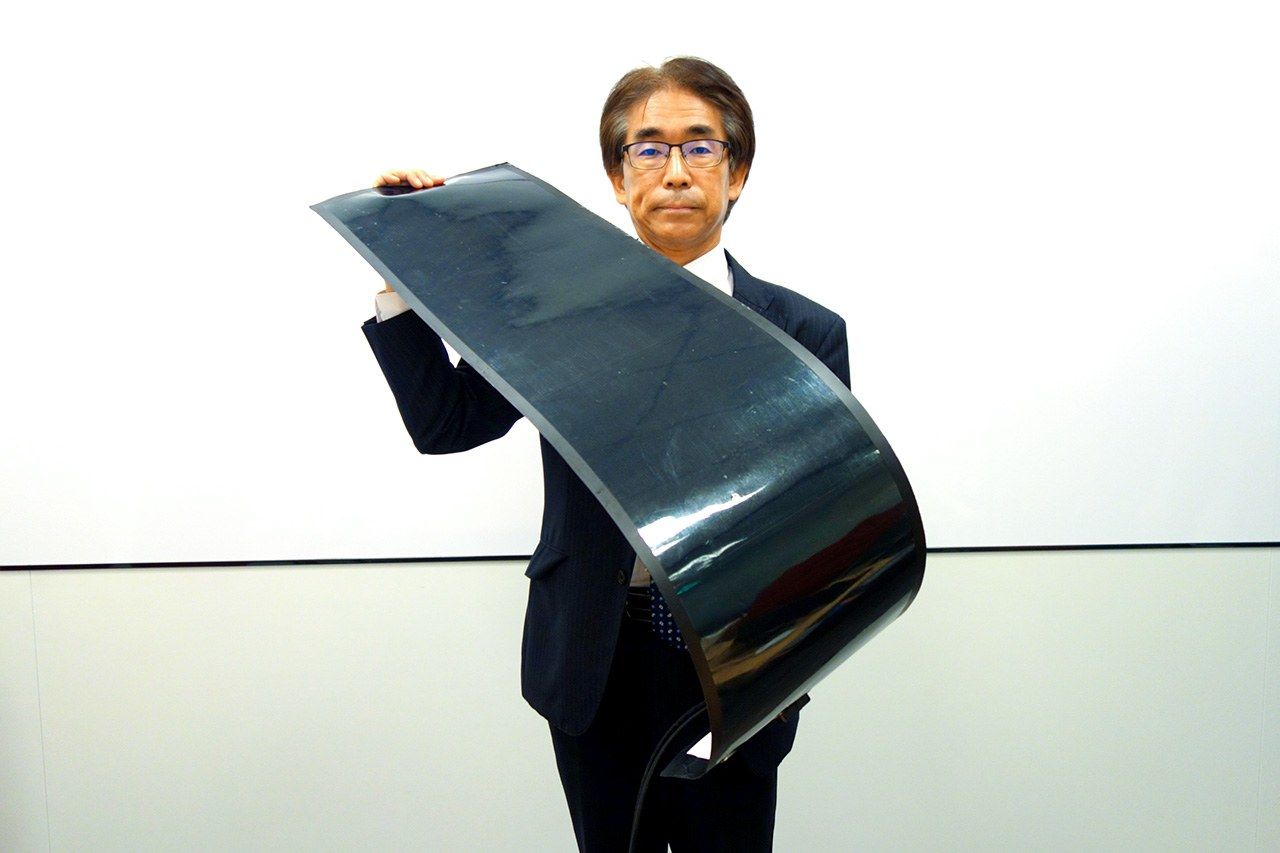
Morita Takeharu of Sekisui Chemical holds a prototype flexible solar cell. (© Mochida Jōji)
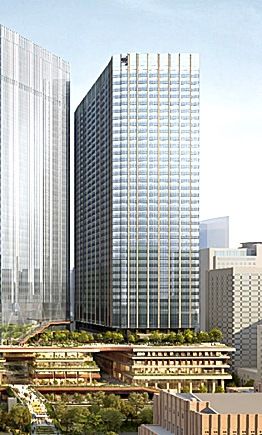
Artist’s impression of a skyscraper planned for Uchisaiwaichō, Tokyo, that will generate electricity through perovskite solar cells in its walls. (Courtesy TEPCO Power Grid)
Manufacturers of the thin-film cells are eyeing the possibility of their use on the roofs of factories and warehouses, which allow for superior exposure to sunlight, but are unsuitable for heavier silicon solar panels. Many potential customers have shown an interest in using the new, lightweight panels. Sekisui Chemical is carrying out an experiment at Tokyo International Cruise Terminal, the gateway to Tokyo Bay, testing the flexible nature of the new panels by attaching them to curved surfaces like pillars (see the main photo for this article above).
Silicon solar panels are also unsuitable for use on vertical walls. However, a 43-story skyscraper—planned for completion in fiscal 2028 as part of urban redevelopment in Uchisaiwaichō in Hibiya, Tokyo—will have thin-film solar cells on its outer walls. It is expected to generate more than 1,000 kilowatts of power.
Homes could also have solar panels on their walls. In areas where there is heavy snowfall, rooftop solar panels become ineffective, but wall-mounted panels could generate power from reflected sunlight during brighter intervals.
A Dream for 2050
The initial production of flexible solar cells will require capital investment for factories and coverage of depreciation costs, meaning high sales prices. As production capacity rises, however, costs drop, smoothing the path to adoption of the new technology. Toshiba Energy Systems & Solutions plans to launch a product between fiscal 2025 and 2030, based on the belief that it will be possible to install everywhere in urban areas by 2050.
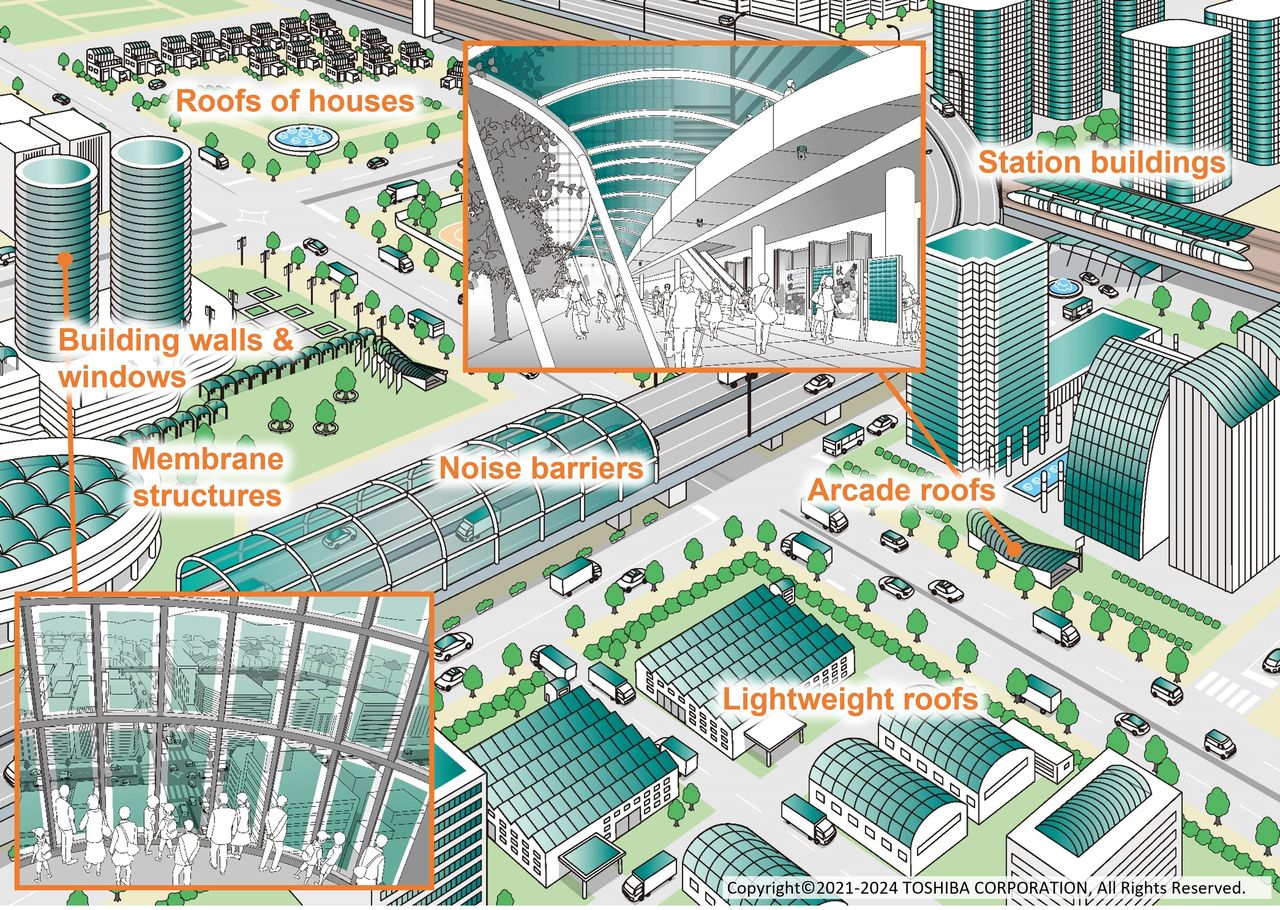
A vision of urban use of flexible solar panels. (© 2021–24 Toshiba Corporation, All Rights Reserved)
If the new solar cells become more affordable, their range of application will grow. Toshiba says that in the agricultural sector, which is suffering from a labor shortage, the use of flexible solar cells in plastic greenhouses could reduce labor needs by regulating temperature and humidity, and automating the spraying of chemicals and fertilizers by drones. The company is also considering the development of rollable solar panels that can be laid out on available spaces as an emergency power generator after a disaster.
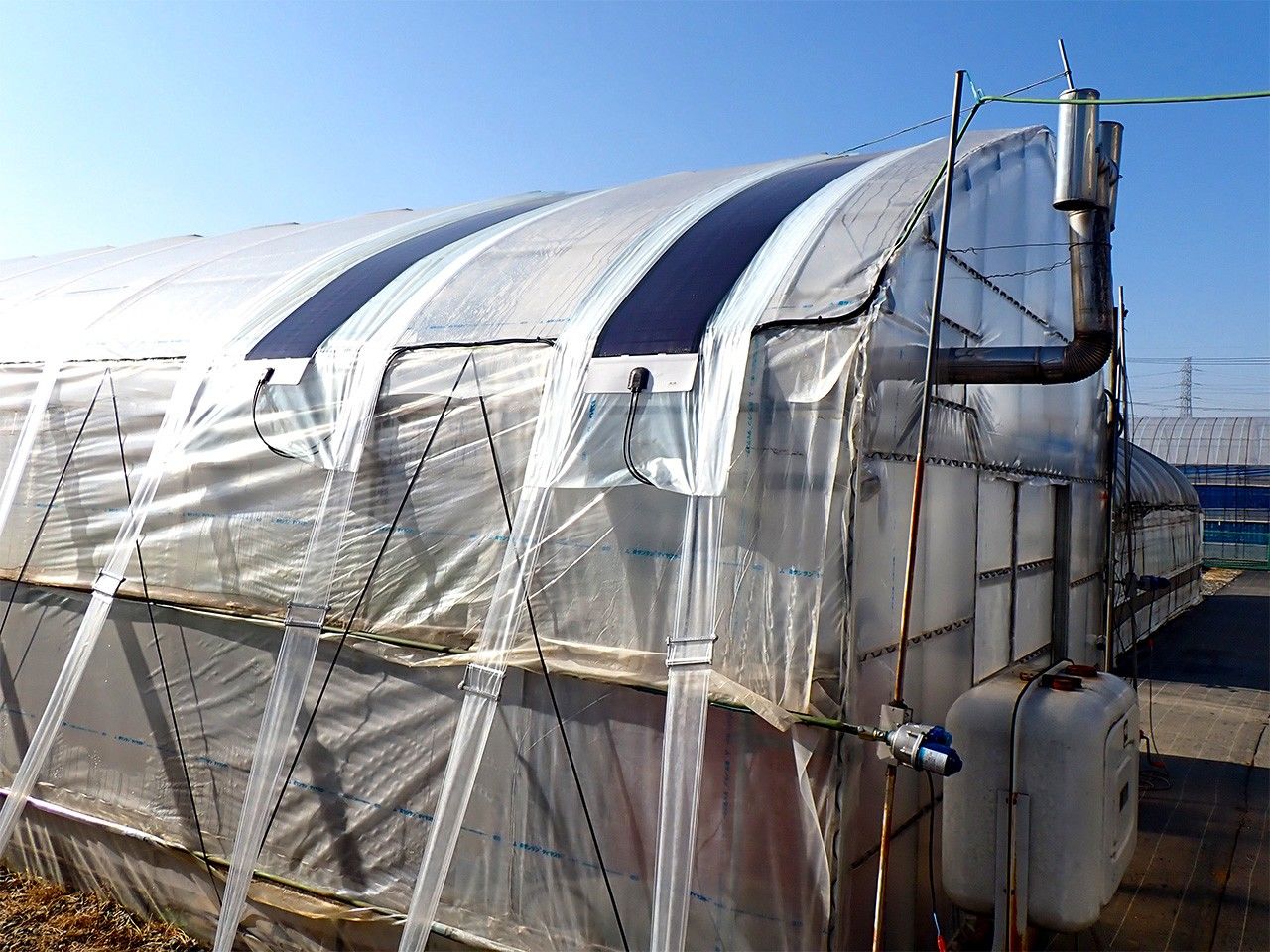
Toshiba Energy Systems & Solutions conducted an experiment together with the Tokyo Metropolitan Government on the use of flexible solar panels in plastic greenhouses. (Courtesy Tokyo Metropolitan Agriculture and Forestry Research Center)
Sakurai Yūsuke, who heads a next-generation solar cell group at Toshiba, explains: “If there’s a certain amount of natural light entering, we can use flexible cells to generate power indoors.” The company is working with the Tokyo Metropolitan Government to test the efficiency of indoor power generation. Potential is seen in areas with good sunlight exposure, such as near windows and in curtain walls (modern buildings’ exterior walls that have no structural function other than protecting against the elements).
Another possible use is as emergency power for electric vehicles. Some hybrid vehicles already offer rooftop silicon solar panels as an option, but the lightweight nature of flexible panels makes for superior energy efficiency. Enecoat Technologies, a Kyoto University start-up, is working with Toyota to develop new solar panels for use in vehicles.
Energy Security Benefits
The uptake of solar power and other renewables ties in with energy security. Japan’s current energy mix centers on thermal power, so it is reliant on imports of fossil fuels like oil, coal, and natural gas. In fiscal 2021, Japan’s energy self-sufficiency was just 13.3%, ranking it thirty-seventh among the 38 OECD members. Spiking oil prices following Russia’s invasion of Ukraine have dealt the economy a major blow. Increased self-sufficiency is essential to evading the negative effects of geopolitical risks.
In current solar panels, electricity is generated using silicon, which mostly comes from China. However, the new panels use iodine, for which Japan is the world’s second biggest producer. With domestically produced materials, there is less danger of disruption to the supply chain, as happened in the semiconductor industry due to US-China antagonism.
Local Production for Local Use
As climate change intensifies, bringing harsher heatwaves, the high cost of electricity is a serious concern for homes and businesses. Electricity transported from distant thermal plants is expensive because it requires major facilities and power grids. Locally produced electricity, such as solar power, on the other hand, is inherently cheaper. And unlike fossil fuels, sunlight is a freely available resource.
Sekisui Chemical’s Morita says, “Once we start mass production, we can make the products cheaper, so at some point, we can sell panels for home use. Although they’re more expensive individually than silicon solar panels, they’re cheaper in terms of total cost, from installation to disposal.”
Toshiba calculates that if flexible solar panels with 15.1% efficiency for converting light into electricity were installed on all the roofs and some of the walls of buildings in the 23 municipalities of central Tokyo, it would generate power equivalent to two nuclear plants, or two-thirds of the area’s annual household energy consumption.
However, major price reductions and technological and design improvements, such as enhanced durability, are necessary to make this vision of the future a reality. There are still a number of obstacles to overcome on the road ahead.
(Originally published in Japanese on August 28, 2024. Banner photo: A flexible solar panel attached to a pillar used to light a “Tokyo” sign at Tokyo International Cruise Terminal as part of an experiment by Sekisui Chemical. © Mochida Jōji of Nippon.com.)

